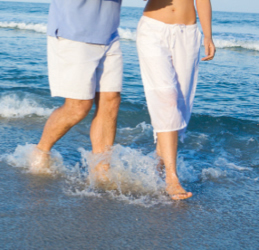Frequently Asked Questions About Sclerotherapy
Information reproduced in part from RadiologyInfo. Org
Sclerotherapy is a minimally invasive treatment most commonly used to treat spider veins. The procedure involves the injection of a solution directly into the affected veins, causing them to shrink and eventually disappear.
There is a type of sclerotherapy called ultrasound-guided sclerotherapy (or echo-sclerotherapy). This type of sclerotherapy uses ultrasound imaging to guide the needle. It is useful in treating larger veins that cannot be seen on the skin’s surface. It may be used after surgery or endovenous techniques if the varicose veins return. This procedure can be done in a doctor’s office. Possible side effects include skin sores, swelling, injection into an artery by mistake, or deep vein thrombosis (a potentially dangerous blood clot).
Sclerotherapy is used to reduce the appearance of spider veins, to treat some types of varicose veins and to relieve some of the symptoms associated with vein disease including aching, burning, swelling and night cramps.
You should report to your doctor all medications that you are taking, including herbal supplements, and if you have any allergies, especially to local anesthetic medications, general anesthesia or to contrast materials (also known as "dye" or "x-ray dye"). Your physician may advise you to stop taking aspirin, nonsteroidal anti-inflammatory drugs (NSAIDs) or a blood thinner for a specified period of time before your procedure.
Also inform your doctor about recent illnesses or other medical conditions.
Ask your doctor about antibiotic medications you may be taking or ask for safe guidelines
for discontinuing these medications.
No lotion should be applied to legs before or after sclerotherapy.
You should wear comfortable, loose-fitting clothing to your exam. You may be given a gown to wear during the procedure.
You may want to bring a pair of shorts to wear during the procedure.
The procedure uses a very fine, thin needle to inject a sterile sclerosing solution into the small veins.
When the sclerosing solution is injected directly into the spider or varicose veins, it irritates the lining of vein, which causes the vein to gradually close. Over time, the vessel turns into scar tissue that fades from view.
This procedure is done on an outpatient basis.
Using a very fine needle, your physician will inject the vein-dissolving solution into the varicose and spider veins. The procedure is sometimes performed using an ultrasound or intense light to better see the enlarged veins. As the procedure continues, you will feel small needle sticks and possibly a mild burning sensation. The number of veins treated in one session varies, and depends on the size and location of the veins.
The procedure is usually completed within 30 to 45 minutes.
You may experience a cramping sensation for one to two minutes when larger varicose veins are injected. After the treatment you will be instructed to wear support hosiery or compression wraps to "compress" the treated vessels.
You may experience certain side effects after sclerotherapy. Larger injected varicose veins may become lumpy and/or hard for several months before resolving. Raised red areas may appear at the injection sites and should disappear within a few days. Brown lines or spots on the skin may be seen at the injection sites. In most cases, they disappear within three to six months, but can be permanent about five percent of the time. Bruising may occur around the injection site and can last several days or weeks.
In general, spider veins respond to sclerotherapy in three to six weeks, and larger veins respond in three to four months. If the veins respond to the treatment, they will not reappear. However, new veins may appear over time. If needed, you may return for more injections.
Benefits:
* Each sclerotherapy session typically results in elimination of 50 to 80 percent of the injected veins.
Risks:
* Any procedure where the skin is penetrated carries a risk of infection. The chance of infection requiring antibiotic treatment appears to be less than one in 1,000.
* Risks include the formation of blood clots in the veins, severe inflammation, adverse allergic reactions to the sclerosing solution and skin injury that could leave a small but permanent scar.
Large varicose veins do not respond as well as small ones to sclerotherapy. A few (less than 10 percent) of people who have sclerotherapy do not respond to the injections at all. In these instances, different solutions or a different method, such as laser therapy, may be attempted.
You will not be able to undergo sclerotherapy treatment if you are pregnant, breastfeeding, or are bedridden. You must wait at least three months after giving birth before you can be considered for this procedure.
Link Library
This panel includes outbound links to trusted sources of medical information such as the National Health Library, Medline and American Heart Lung and Blood Institute. Links will direct you to a new browser window. Please note that all information contained at these web sites is meant for informational purposes only, and is not intended as a substitute for an actual physician visit.
National Health Library | American Heart Lung and Blood Institute - Overview, FAQs and more
http://www.nhlbi.nih.gov/health/dci/Diseases/vv/vv_all.html
National Health Library | Medline Plus
Varicose Vein Introduction and Associated Links







 Effective August 30, 2017: Now welcoming patients at our new location, 5300 Katella Avenue in Los Alamitos.
Effective August 30, 2017: Now welcoming patients at our new location, 5300 Katella Avenue in Los Alamitos. 

